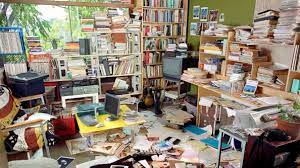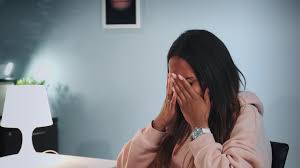Do you have a lot of clutter?
Often, when people think about piles of clutter, something like the below image comes to mind:

But clutter doesn’t always look like this.
Physical Clutter:
- Our space may be neat, but overcrowded, with every surface having multiple objects on them.
- We may have too many things of just one or two types – too many clothes or kitchen vessels or books or shoes or art supplies or decorative pieces… the options go on.
- We may have tons of old things which we have lost track of years ago – nostalgic items from yesteryears, the clothes we wore when we were thinner/bigger, old cd’s, mountains of office files, Sightseeing photographs which are no longer of relevance, things which belonged to our loved ones who are no longer with us.
Digital Clutter:
- Tens of thousands of photos, videos, files and texts which may be blocking up our drives and our devices.
Emotional/Mental Clutter:
- Old narratives that we keep repeating – “——-his did this-this-this to me or a loved one. How could they have done this? I need to show them!”
- Storehouses of unprocessed anger, resentment, grief, guilt or shame.
- Gossip – family/friends/relatives/workplace gossip that we store and pass on.
- Racing thoughts of fear or worry that keep running through our minds
Almost every one of us has clutter of some kind or the other. The thing with clutter is that when it is accumulating, it seems too small to be a problem, and once it becomes a problem, it becomes too overwhelming to face. And so we let it pile on, thinking that ignoring it is easier.

Unfortunately, ignoring/ dismissing the problem only makes it worse.
Clutter weighs us down, in more ways than one. It literally clouds our thinking, constantly keeping us in a space of anxiety, overwhelm and frustration without us even realising why. It silently blares out messages of criticism, and makes us feel like we have a never-ending list of things to do, that we have fallen back on again. It wears us down, to the point where we may feel drained all the time, without even knowing why.
Often, it is only when the clutter is gone that we realise how much easier it is to breathe, think, function and be.
If you relate to any of this, here are some things you can do to start decluttering.
Physical clutter:
Pick one space. Any one space. It can be a shelf, a corner, a cupboard, a desk, anything. Separate the items into 3 piles: 1) Keep 2) Discard 3)Not sure/Maybe.
Discard or give away the items from pile 2. Keep the items in pile 1 and 3 and evaluate it as the week goes by. Discard or donate whatever you feel you can let go off. Congratulations! You have taken your first step. Feel free to repeat this as many times as you like. Remember, you don’t have to force yourself to discard. You are not doing this to punish yourself. You are doing it to free yourself.
Digital Clutter:
Choose a drive or device that you would like to start clearing out. Set a timer for 10 minutes. During that time, repeat the same process as above. Do this just three times this week.
Emotional Clutter:
While there are several ways to release emotional clutter: therapy, bio-energetic work, scribbling, etc; the most powerful and lasting way to dissolve emotional clutter is to engage in deep, experiential forgiveness work.
If you would like to learn how to release, let go and forgive, check out our forgiveness courses! Message us at +91 98402 30151 or glsworkshops@gmail.com for more details!

